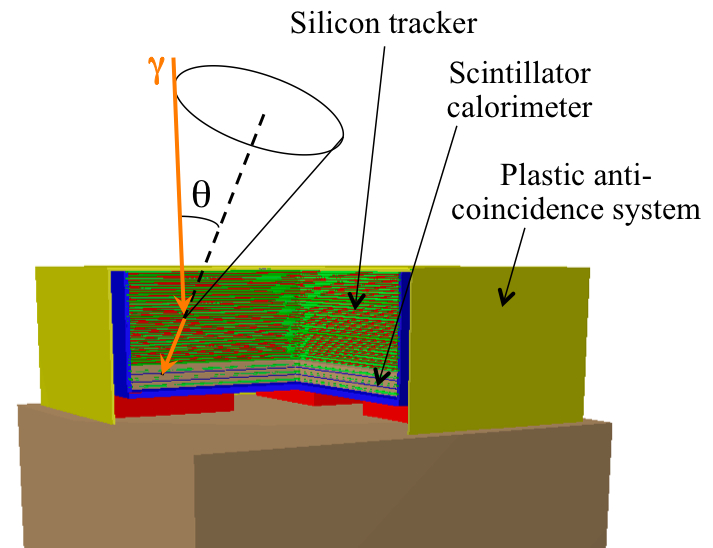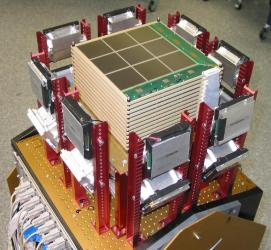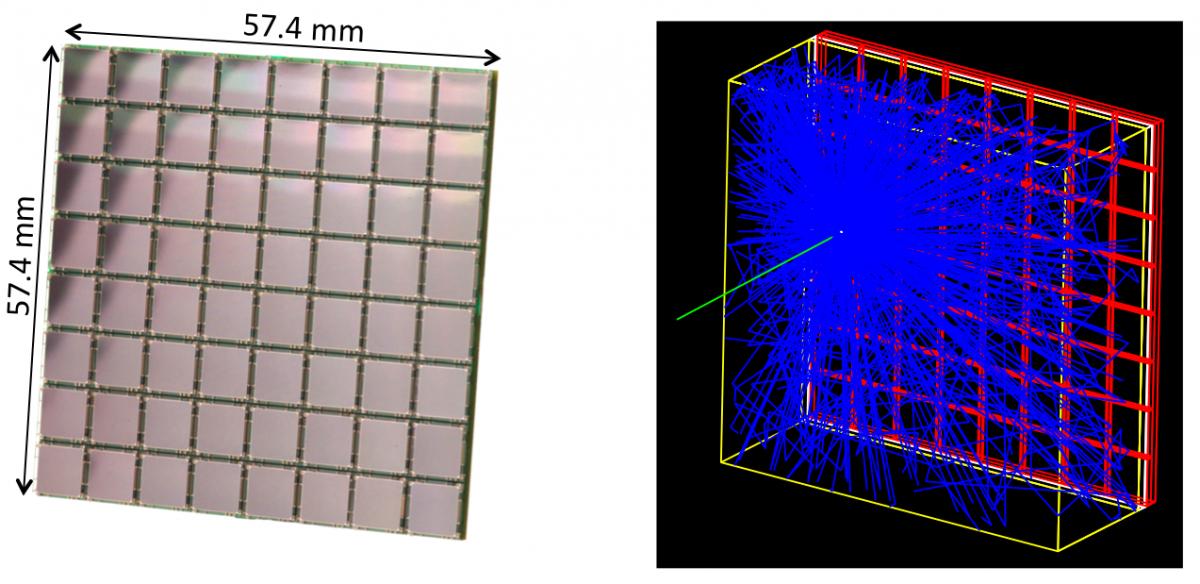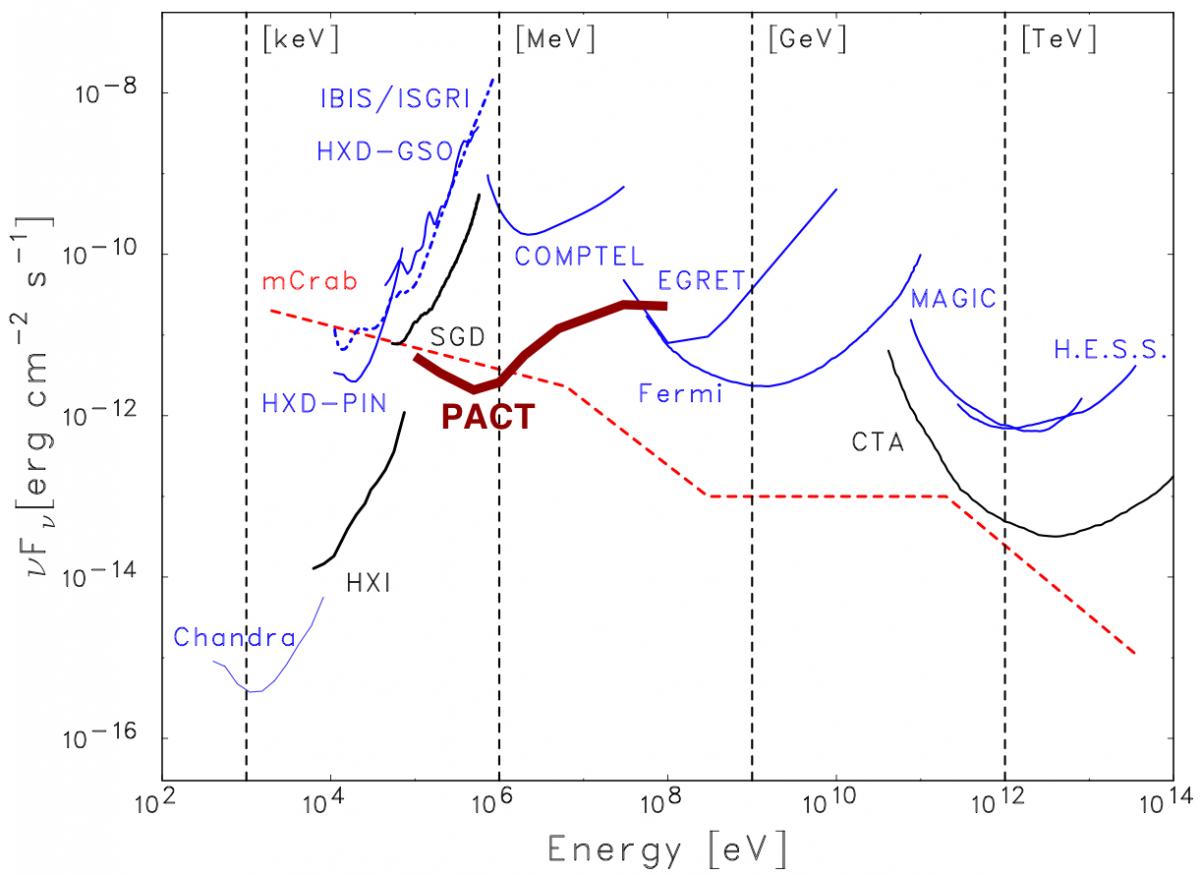To best meet the diversity of scientific objectives that can be addressed in the MeV domain, the next gamma-ray observatory will cover a wide energy band (typically 100 keV to 100 MeV) and reach a sensitivity 50-100 times better than those of CGRO/COMPTEL and INTEGRAL. The best concept to fulfil these requirements is a square-meter class instrument composed of two main detectors: a gamma-ray tracker made of a stack of double-sided silicon stripped detectors and a calorimeter composed of an ensemble of position-sensitive scintillator modules. In addition, an anticoincidence system made of plastic scintillator panels can efficiently suppress the instrumental background components due to cosmic-ray-induced prompt reactions (Figure 1).
Figure 1

Mass model of a Compton and pair-creation telescope. Also represented is an event with a Compton scattering in the silicon tracker followed by absorption of the scattered photon in the calorimeter |
Below 10 MeV, the photon detection is based on the Compton imaging technique successfully used with COMPTEL (see Figure 1). Interestingly, a compact Compton telescope will also be a highly sensitive polarimeter. Above 10 MeV, the instrument measures the paths and energies of the electrons and positrons produced by pair conversion of incident gamma rays, like in the Fermi Large Area Telescope.
A prototype of a Compton and pair-creation telescope has already been built at MPE about a decade ago (Figure 2). Various technological developments made since then should enable a significant gain in detection sensitivity. Thus, 2-mm thick double-sided silicon strip detectors (DSSSDs) with 100 cm2 active area are now commercially available. The use of thick DSSSDs will allow us to reduce the number of required detectors (and therefore the price of the instrument), the amount of passive material, the number of electronics channels and thus the power requirements.
Figure 2

Photograph of the MEGA telescope developed at MPE (Germany) in the late 90s and early 2000s. |
New inorganic scintillators such as co-doped cerium bromide (e.g. CeBr3:Sr), or alternatively some non-hygroscopic transparent ceramics, are very promising materials for the calorimeter. A suitable three-dimensional position sensitive module can be obtained by coupling a novel scintillator crystal with a large array of silicon photomultipliers (SiPM). These new photodetectors are very attractive for the readout of scintillation crystals in a space instrument, since they are very compact and robust, and provide high gain with low supply voltage.
Figure 3

Array of 8×8 silicon photomultipliers (SiPM) developed by SensL (left), and GEANT4 simulation of a calorimeter module composed of a 2 cm thick crystal of CeBr3 coupled to an SiPM array (right). |
The performances of a telescope model called PACT (Pair And Compton Telescope) have been simulated with the MEGAlib software toolkit. In this model, the tracker is composed of thirty layers of 12×12 DSSSDs and the calorimeter of three layers of 24×24 CeBr3 modules (as shown in Figure 3). The instrument has been placed into an equatorial low-Earth orbit at a typical altitude of 550 km. As shown in Figure 4, this telescope would provide an important leap in sensitivity in the medium energy gamma-ray band, allowing the detection of new MeV sources at the mCrab level.
Figure 4

Point source continuum sensitivity of different X and γ-ray instruments (adapted from Takahashi et al. 2012). The curves for Chandra/ACIS-S, Suzaku/HXD (PIN, GSO), INTEGRAL/IBIS and ASTRO-H (HXI, SGD) are given at 3σ for an observing time Tobs = 100 ks. The COMPTEL and EGRET sensitivities are given for the observing time accumulated during the whole duration of the CGRO mission (~9 years). The Fermi/LAT sensitivity is given at 5σ for a high Galactic latitude source and Tobs = 1 year (Atwood et al. 2009). For MAGIC (Carmona et al. 2011), H.E.S.S. (Aharonian et al. 2006) and CTA (Actis et al. 2011) the sensitivities are given at 5σ for 50 hours. The PACT sensitivity is the 3σ detection limit for 5 years in survey mode and ΔE = E. |




 AstroMeV
AstroMeV